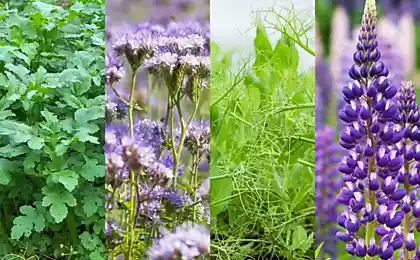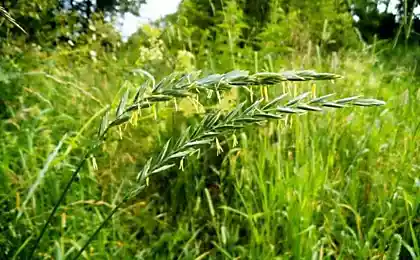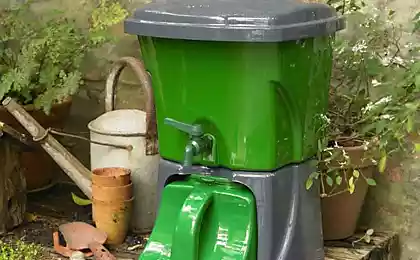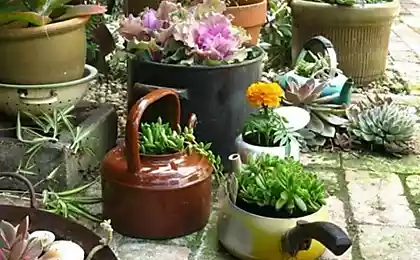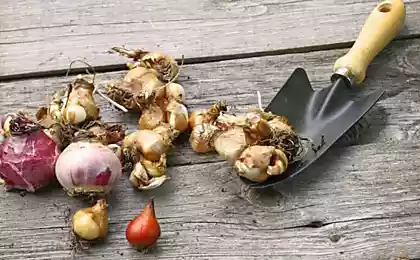581
How to fight soil erosion with cover crops
The reasons why farmers use soil culture are as varied as the number of types that can be used as a cover crop. Traditionally, cover crops are used that the soil is not eroded. Current problems with water quality and soil erosion brought groundcover to the front. Cover crops are a great tool that farmers can use to minimise soil movement from the field. Active roots hold the soil from water erosion, and the leaf mass on the surface creates a shield from wind erosion. The coating protects the soil from rainfall splash.
A rating of plants can significantly help
Excellent: barley, rye, sorghum, some
Very good: oats, wheat, mustard, canola, peas, radishes, pink clover, white clover, sweet clover, lupine, phacelia
Good: vetch, red clover, buckwheat

In order to obtain maximum performance, it is necessary to familiarize with a particular type of green manure that are most suitable for your conditions and your land.

The most common plants, green manures, are considered white mustard, rye, oats, lupine, phacelia, vetch and canola. On the use of each of them will be discussed below.
Phacelia isthe biggest benefit of this green manure is that after it can be planted any crop. Phacelia belongs to the family buravchikov to which none of the cultivated plants of the middle band does not belong. It can be spread before or after any of the vegetables, grains and herbs. Application rate of 8-10 g/m. Thanks to the "social class", this plant is suitable for fertilizing land under cabbage, radishes, turnips, as they are often affected by insect pests.
Phacelia is a very quick rises and develops (45-55 days), forming the lush tufts of greenery growing from the same root. The form of the aerial part it got its name because in Latin, Phacelia is a beam. Externally, it looks very attractive. Purple flowers and leaves carved-look decorative, and are appropriate for filling empty spaces in the beds, flower beds and high ridges.
Embedded in the soil phacelia improves its fertility is not less than cow dung.Introducing foliage into the soil (about 100 kg/sq. m), equivalent to 1 ton of humus on the same plot of land. But to cook plant biomass can be much faster, and it will cost cheaper than the organic fertilizers of animal origin.
Another very useful property of this flower, which is not found in other plants belonging to conditional "green fertilizers" – its nectar attracts enemies, destroying insect pests. Moth, aphids and leafroller disappear from the infield. Phacelia is often planted as a protective barrier Descartes, to protect the plants from pests. Neighborhood with her not tolerate wireworms, grasshoppers and soil nematodes just killed by inhalation of its emitted colors of fungicides. At the same time, this flower has no negative impact on bees, and is a perfect melliferous plant. Some bee-keepers specially planted phacelia entire plantations to get flower honey with excellent taste.
How to grow phacelia seeds?Phacelia – green manure is the best by such indicators as the versatility. Therefore, many gardeners want to see her on the site. But its seeds are expensive. And one of the most important advantages of bio-humus – low cost of use. If this factor is offset by the high cost of seeds, and in a sense the sowing of this plants.
Many gardeners have learned to circumvent this obstacle by growing the seeds on their own. To do this, leave the site, away from the garden to ripen seeds was sprinkled on the beds. Then wait until the flowers fall off from a large part of spikelet. The stems are cut and dried in closed, well-ventilated area with low humidity. Well dried phacelia threshed, and get a great seed, not inferior to store-bought counterparts.
White mustardThis cold-hardy green manure can be grown and filled into the ground several times a season. Her last planting for the winter, a few weeks before the onset of cold weather. Do this in order to green mass "has broken" the cold, and she would have to humus under a layer of snow. The process of decay will continue for some time after the onset of low temperatures due to internal heat released during the decomposition of plant organic matter. It will be enough to turn fertilizer-green manure into humus, which is very useful plants in the spring.
Mustard boards together, and very quickly gaining vegetative mass. It is very important not to "miss" the moment when the stems begin to harden. Greens need to mow until it turned yellow, before the appearance of first flowers as soon as I poured the first ovary of the flower buds.
The minimum period from planting to incorporation of this plant into the soil five weeks, but, if possible, it is better to wait all eight. When calculating the timing of harvesting should be considered that in hot weather, the stems harden faster, cold slower, so in autumn and spring you can leave the herbs in the beds for a long time.
Sown mustard is usually "random", except in those cases where it is used to protect plants from pests. Then apply the inline method. The rate of application of seed this autumn – 4-7 g per 1 sq. m. If you sow more, landing thickens, and can start rotting greens on the vine.
To accelerate the maturation of vegetable humus, the green mass obtained from plantings of mustard, you can pour bio-stimulator. For this purpose perfectly suited Baikal, which was diluted in a proportion 1:1000 (drop per liter of water), with spray solution sprayed with grass clippings. Under the action of live bacteria contained in the product, the grass rot faster, and becomes part of the soil system.
Video: mustard and other cover crops — planting and the result
Lupinis One of the oldest green manure in the history of agriculture is the common lupine. To enrich the soil, low in nitrogen, it was used in Greece more than two thousand years ago. Gardeners entirely buried the trunk and leaves without roots in tree trunks fruit tree, and nitrogen that is enough for several months.
This plant belongs to the legume family, respectively, beans, peas, and beans are after it can not be planted, these crops are common pests. Perfect for followers of lupine will be tomatoes, cabbage, peppers. As for potatoes, this beautiful flower will be the best predecessor.
Powerful the roots of plants are active baking powder, penetrating deeply into the soil. In parallel, they have another positive effect – saturate the nitrous bacteria in all soil horizons. Planting of lupine can accumulate in the ground about 200 kg of nitrogen per 1 hectare.
This green manure planted in the early spring, in-line method. The consumption of seeds (and they are quite large) – 4-5 sq. m. When the Lupin age 5-7 weeks, tops plowed into the ground. Even if it bloomed, it's not terrible, most importantly, to prevent the formation of seeds, as in this stage of plant development the stem becomes hard, and bad rot in the soil.
The great advantage of the plants can be considered as pivotal root system that goes deep into the ground and obtains most of its nutrients from deep layers, not impoverishing the upper fertile layer. The vermicompost obtained from the aerial parts of lupine, per 1 sq. m. replaces 4 kg of manure or 40-50 g of urea.
RyeIn many regions of the country made after the digging of potatoes to plant a vegetable garden this cereal. Great rye tillers, and increases the green mass, reaching 200-300 kg with a weave. This green manure is planted as a winter and spring planting time does not affect its quality. The special value of winter rye is that inactive increases biological mass even at fairly low temperatures, and winter crops survive even in the snowless winters, with temperatures down to -25°C.
The downside of all cereals grown for enriching the soil, including rye, is the complexity of the recycling and plowing. The stems have a fairly solid structure, long decay, and cling to the ploughshare plough, who have all the time to clean. Another disadvantage of this winter green manure can be considered that it strongly dries up soil, so the garden among the trees of rye to sow impossible.
Otherwise, this cereal is a great fertilizer, seeds which are inexpensive, and therefore accessible to all. Rye is undemanding to the quality and thickness of the soil layer padernal the bulk soil, easily reconciled with the high acidity. As this plant has a fibrous root system, it easily keeps nutrients in the top soil horizon, not allowing them to be washed away with the meltwater and rain runoff.
A great advantage of this fertilizer-green manure is that decompose, it enriches the soil not only of nitrogen but also calcium. Microorganisms found in cereals biomass and create conditions for absorption of hard to digest phosphorus compounds, dissolving them. Accordingly, the earth is full of NPK-complex nutrients, which enables you to grow any crops-followers.
The aboveground part of grasses after cutting, is used not only for ploughing. The resulting straw is used as mulch. It provides excellent protection of the soil from drying out, and does not reach to the surface of the seeds of weeds. Subsequently, decomposing, fresh straw becomes part of the garden, turning into vermicompost.
OatsThis cereal culture is used as a green manure less than rye. But it is rather a coincidence than a pattern. The plant has all the positive qualities of rye, while still outperforms it in some respects. For example, oats are even more unpretentious. It can be spread on acidic podzolic soil, clay and even peat – it will grow everywhere.
Oat-green manure in combination with clover
As part of his rotation after legumes are planted, preparing the ground for potatoes. Despite the apparent weakness of the fibrous root system, this plant is perfectly loose soil to great depths, enriching it with oxygen, and creating comfort for cultivated plants structure. Oats saturates the upper soil layer nitrogen and potassium, as well as the rye decomposes harder to digest phosphorus compounds.
Plant the seeds of this crop, scattering them over the surface of the pre-opening of the land in early spring, as soon as you can go in the garden. Don't be afraid of the mud and the cold – oats loves them, and on germination, these parameters are not affected. On the contrary, at the end of March – beginning of April created optimal conditions for the germination of oats, as it is able to feed on soil moisture from melted snow. Sowing rate is 1.5-2.1 kg per sq. m., depth of seal of seeds – 4-5 see
The cultivation of potatoes, oats, Agricultural technologies, like any other, is not standing still. In modern horticulture increasingly finds use of the technology of growing crops without prior ploughing the land. It saves not only time and effort, but also to excellent yields. Green manure, as part of the culture of no-tillage farming are used in this system.
Oats can be not only a supplier of vermicompost. It can be used for potatoes, growing tubers in the mulch of oat straw. And, on the allotment, which is scheduled for this culture don't even have to remove the grass, she would disappear by going to the composition of the nutrient of the soil. It only needs a little push, and in between, to make furrows, and planting oats.
When the green manure and weeds old enough, mow them at the root with plane and making a small depression in the ground, throw in a potato, lightly sprinkled it with layer of earth. Emerging sprouts are mulched with straw and grass, and when they become quite large, gradually pour the other green waste, such as grass remaining after mowing the lawn. Most importantly, you need to block access to the tubers to sunlight, which "makes" them, making potatoes unfit for human consumption.
After the fall harvest of potatoes, which, incidentally, will be very clean and quick process, the field must re-sow the oats, and continue to do so every year. A couple of years without digging the soil structure is fully restored, and the land will give consistently high yields.
Vetchvetch (vetch) is a plant early, and has a short vegetation time, which allows its use as intermediate crops between plantings of main crops. For example, it can be put on the beds intended for planting tomatoes, peppers and eggplant. Before melons it is also possible to sow. Pumpkin, zucchini, squash planted "Vic", give excellent yields.
Planting green manure is done throughout the growing season, once established zero temperature. Sowing rate – 1.5 kg per one hundred square meters. A seeding depth of 1-3 cm Deeper is not necessary, otherwise the plant will not be able to penetrate the surface layer of soil. To speed germination, the plot can be watered EM-fertilizer, it's cheap and fast.
Often the Vic include in the mixture, which includes such plants cover crops like rye, oats, canola and rye. This is done to obtain the optimal composition of vermicompost, which is formed after cutting of crops, as this plant accumulates mainly nitrogen. "Vetch" to belong to the legume family, and therefore has a similar structure. His roots are formed the same nitrogen nodules, which accumulate this element. Peas, beans and broad beans to plant after him is impossible. But potatoes, cabbage, radish, cucumbers and herbs are a great subsequent crops.
Sweet cloverBefore it is a herbaceous plant used as forage crops for livestock. But then he noticed that the plowing of the meadows, where the clover grew, the earth produced richer yields than fields that were seeded with other herbs. After that, the clover was used as a green manure.
It is a biennial plant that is grown as an annual. Clover is unpretentious, hardy and fast growing. He belongs to the legume family, so it can accumulate nitrogen in the root system. Its roots penetrate deep into the ground, and have a large number of branches. Thanks to powerful root system of this plant, after cutting the earth to dig is not necessary. It will be loose without additional processing.
The peculiarity of the cultivation of clover is that the most useful it is not considered to be aboveground and underground part. So to cut the plant as early as 3-4 weeks after emergence. If you give it to overgrow, it becomes too firm for further processing, and the "horns" of its stems will over a couple of seasons stuck in the beds, completely decorating the garden.
RadishOilseed radish is a unique green manure, fast-growing aerial parts. For 6 – 7 weeks, she can increase its vegetative mass 4-5 times. It is popular among gardeners as a natural "errokiller". Radish suppresses all the weeds, even Wheatgrass.
This green manure is not only active supplier of biomass. Radish – a natural doctor and cleaner earth. She successfully fights such diseases as Clubroot of cabbage, and nematode. It should be planted on land that has been affected by various diseases and insect pests for several seasons, and the soil will again become healthy.
Sow radish is best on a fresh ploughed land, she loves the soft ground. The consumption of seeds – 300 g per hundred. 4 weeks after the appearance of full shoots aboveground part of the plant was excised with a shovel, and dug along with the soil. The thickest stems are best put in the compost.
***
The use of green manures allows you to restore soil balance, to save money on purchased fertilizer, and growing organic products. Application of green manure helps to create new humus layer, which was destroyed when applying traditional farming, when all the nutrients were passed from the soil with the resulting products. Enriched with natural methods soil to be transformed, and will always reward for all the effort abundant crops of organic vegetables and fruits.
Video: green manure in the country — sowing, seed collection, efficiency
7 useful ideas what to do with fallen leaves
Gasification furnace for an eco house – practical and modern
P. S. And remember, only by changing their consumption — together we change the world! ©
Source: udobreniya.info/domashnie/sideraty/
A rating of plants can significantly help
Excellent: barley, rye, sorghum, some
Very good: oats, wheat, mustard, canola, peas, radishes, pink clover, white clover, sweet clover, lupine, phacelia
Good: vetch, red clover, buckwheat

In order to obtain maximum performance, it is necessary to familiarize with a particular type of green manure that are most suitable for your conditions and your land.

The most common plants, green manures, are considered white mustard, rye, oats, lupine, phacelia, vetch and canola. On the use of each of them will be discussed below.
Phacelia isthe biggest benefit of this green manure is that after it can be planted any crop. Phacelia belongs to the family buravchikov to which none of the cultivated plants of the middle band does not belong. It can be spread before or after any of the vegetables, grains and herbs. Application rate of 8-10 g/m. Thanks to the "social class", this plant is suitable for fertilizing land under cabbage, radishes, turnips, as they are often affected by insect pests.
Phacelia is a very quick rises and develops (45-55 days), forming the lush tufts of greenery growing from the same root. The form of the aerial part it got its name because in Latin, Phacelia is a beam. Externally, it looks very attractive. Purple flowers and leaves carved-look decorative, and are appropriate for filling empty spaces in the beds, flower beds and high ridges.
Embedded in the soil phacelia improves its fertility is not less than cow dung.Introducing foliage into the soil (about 100 kg/sq. m), equivalent to 1 ton of humus on the same plot of land. But to cook plant biomass can be much faster, and it will cost cheaper than the organic fertilizers of animal origin.
Another very useful property of this flower, which is not found in other plants belonging to conditional "green fertilizers" – its nectar attracts enemies, destroying insect pests. Moth, aphids and leafroller disappear from the infield. Phacelia is often planted as a protective barrier Descartes, to protect the plants from pests. Neighborhood with her not tolerate wireworms, grasshoppers and soil nematodes just killed by inhalation of its emitted colors of fungicides. At the same time, this flower has no negative impact on bees, and is a perfect melliferous plant. Some bee-keepers specially planted phacelia entire plantations to get flower honey with excellent taste.
How to grow phacelia seeds?Phacelia – green manure is the best by such indicators as the versatility. Therefore, many gardeners want to see her on the site. But its seeds are expensive. And one of the most important advantages of bio-humus – low cost of use. If this factor is offset by the high cost of seeds, and in a sense the sowing of this plants.
Many gardeners have learned to circumvent this obstacle by growing the seeds on their own. To do this, leave the site, away from the garden to ripen seeds was sprinkled on the beds. Then wait until the flowers fall off from a large part of spikelet. The stems are cut and dried in closed, well-ventilated area with low humidity. Well dried phacelia threshed, and get a great seed, not inferior to store-bought counterparts.
White mustardThis cold-hardy green manure can be grown and filled into the ground several times a season. Her last planting for the winter, a few weeks before the onset of cold weather. Do this in order to green mass "has broken" the cold, and she would have to humus under a layer of snow. The process of decay will continue for some time after the onset of low temperatures due to internal heat released during the decomposition of plant organic matter. It will be enough to turn fertilizer-green manure into humus, which is very useful plants in the spring.
Mustard boards together, and very quickly gaining vegetative mass. It is very important not to "miss" the moment when the stems begin to harden. Greens need to mow until it turned yellow, before the appearance of first flowers as soon as I poured the first ovary of the flower buds.
The minimum period from planting to incorporation of this plant into the soil five weeks, but, if possible, it is better to wait all eight. When calculating the timing of harvesting should be considered that in hot weather, the stems harden faster, cold slower, so in autumn and spring you can leave the herbs in the beds for a long time.
Sown mustard is usually "random", except in those cases where it is used to protect plants from pests. Then apply the inline method. The rate of application of seed this autumn – 4-7 g per 1 sq. m. If you sow more, landing thickens, and can start rotting greens on the vine.
To accelerate the maturation of vegetable humus, the green mass obtained from plantings of mustard, you can pour bio-stimulator. For this purpose perfectly suited Baikal, which was diluted in a proportion 1:1000 (drop per liter of water), with spray solution sprayed with grass clippings. Under the action of live bacteria contained in the product, the grass rot faster, and becomes part of the soil system.
Video: mustard and other cover crops — planting and the result
Lupinis One of the oldest green manure in the history of agriculture is the common lupine. To enrich the soil, low in nitrogen, it was used in Greece more than two thousand years ago. Gardeners entirely buried the trunk and leaves without roots in tree trunks fruit tree, and nitrogen that is enough for several months.
This plant belongs to the legume family, respectively, beans, peas, and beans are after it can not be planted, these crops are common pests. Perfect for followers of lupine will be tomatoes, cabbage, peppers. As for potatoes, this beautiful flower will be the best predecessor.
Powerful the roots of plants are active baking powder, penetrating deeply into the soil. In parallel, they have another positive effect – saturate the nitrous bacteria in all soil horizons. Planting of lupine can accumulate in the ground about 200 kg of nitrogen per 1 hectare.
This green manure planted in the early spring, in-line method. The consumption of seeds (and they are quite large) – 4-5 sq. m. When the Lupin age 5-7 weeks, tops plowed into the ground. Even if it bloomed, it's not terrible, most importantly, to prevent the formation of seeds, as in this stage of plant development the stem becomes hard, and bad rot in the soil.
The great advantage of the plants can be considered as pivotal root system that goes deep into the ground and obtains most of its nutrients from deep layers, not impoverishing the upper fertile layer. The vermicompost obtained from the aerial parts of lupine, per 1 sq. m. replaces 4 kg of manure or 40-50 g of urea.
RyeIn many regions of the country made after the digging of potatoes to plant a vegetable garden this cereal. Great rye tillers, and increases the green mass, reaching 200-300 kg with a weave. This green manure is planted as a winter and spring planting time does not affect its quality. The special value of winter rye is that inactive increases biological mass even at fairly low temperatures, and winter crops survive even in the snowless winters, with temperatures down to -25°C.
The downside of all cereals grown for enriching the soil, including rye, is the complexity of the recycling and plowing. The stems have a fairly solid structure, long decay, and cling to the ploughshare plough, who have all the time to clean. Another disadvantage of this winter green manure can be considered that it strongly dries up soil, so the garden among the trees of rye to sow impossible.
Otherwise, this cereal is a great fertilizer, seeds which are inexpensive, and therefore accessible to all. Rye is undemanding to the quality and thickness of the soil layer padernal the bulk soil, easily reconciled with the high acidity. As this plant has a fibrous root system, it easily keeps nutrients in the top soil horizon, not allowing them to be washed away with the meltwater and rain runoff.
A great advantage of this fertilizer-green manure is that decompose, it enriches the soil not only of nitrogen but also calcium. Microorganisms found in cereals biomass and create conditions for absorption of hard to digest phosphorus compounds, dissolving them. Accordingly, the earth is full of NPK-complex nutrients, which enables you to grow any crops-followers.
The aboveground part of grasses after cutting, is used not only for ploughing. The resulting straw is used as mulch. It provides excellent protection of the soil from drying out, and does not reach to the surface of the seeds of weeds. Subsequently, decomposing, fresh straw becomes part of the garden, turning into vermicompost.
OatsThis cereal culture is used as a green manure less than rye. But it is rather a coincidence than a pattern. The plant has all the positive qualities of rye, while still outperforms it in some respects. For example, oats are even more unpretentious. It can be spread on acidic podzolic soil, clay and even peat – it will grow everywhere.
Oat-green manure in combination with clover
As part of his rotation after legumes are planted, preparing the ground for potatoes. Despite the apparent weakness of the fibrous root system, this plant is perfectly loose soil to great depths, enriching it with oxygen, and creating comfort for cultivated plants structure. Oats saturates the upper soil layer nitrogen and potassium, as well as the rye decomposes harder to digest phosphorus compounds.
Plant the seeds of this crop, scattering them over the surface of the pre-opening of the land in early spring, as soon as you can go in the garden. Don't be afraid of the mud and the cold – oats loves them, and on germination, these parameters are not affected. On the contrary, at the end of March – beginning of April created optimal conditions for the germination of oats, as it is able to feed on soil moisture from melted snow. Sowing rate is 1.5-2.1 kg per sq. m., depth of seal of seeds – 4-5 see
The cultivation of potatoes, oats, Agricultural technologies, like any other, is not standing still. In modern horticulture increasingly finds use of the technology of growing crops without prior ploughing the land. It saves not only time and effort, but also to excellent yields. Green manure, as part of the culture of no-tillage farming are used in this system.
Oats can be not only a supplier of vermicompost. It can be used for potatoes, growing tubers in the mulch of oat straw. And, on the allotment, which is scheduled for this culture don't even have to remove the grass, she would disappear by going to the composition of the nutrient of the soil. It only needs a little push, and in between, to make furrows, and planting oats.
When the green manure and weeds old enough, mow them at the root with plane and making a small depression in the ground, throw in a potato, lightly sprinkled it with layer of earth. Emerging sprouts are mulched with straw and grass, and when they become quite large, gradually pour the other green waste, such as grass remaining after mowing the lawn. Most importantly, you need to block access to the tubers to sunlight, which "makes" them, making potatoes unfit for human consumption.
After the fall harvest of potatoes, which, incidentally, will be very clean and quick process, the field must re-sow the oats, and continue to do so every year. A couple of years without digging the soil structure is fully restored, and the land will give consistently high yields.
Vetchvetch (vetch) is a plant early, and has a short vegetation time, which allows its use as intermediate crops between plantings of main crops. For example, it can be put on the beds intended for planting tomatoes, peppers and eggplant. Before melons it is also possible to sow. Pumpkin, zucchini, squash planted "Vic", give excellent yields.
Planting green manure is done throughout the growing season, once established zero temperature. Sowing rate – 1.5 kg per one hundred square meters. A seeding depth of 1-3 cm Deeper is not necessary, otherwise the plant will not be able to penetrate the surface layer of soil. To speed germination, the plot can be watered EM-fertilizer, it's cheap and fast.
Often the Vic include in the mixture, which includes such plants cover crops like rye, oats, canola and rye. This is done to obtain the optimal composition of vermicompost, which is formed after cutting of crops, as this plant accumulates mainly nitrogen. "Vetch" to belong to the legume family, and therefore has a similar structure. His roots are formed the same nitrogen nodules, which accumulate this element. Peas, beans and broad beans to plant after him is impossible. But potatoes, cabbage, radish, cucumbers and herbs are a great subsequent crops.
Sweet cloverBefore it is a herbaceous plant used as forage crops for livestock. But then he noticed that the plowing of the meadows, where the clover grew, the earth produced richer yields than fields that were seeded with other herbs. After that, the clover was used as a green manure.
It is a biennial plant that is grown as an annual. Clover is unpretentious, hardy and fast growing. He belongs to the legume family, so it can accumulate nitrogen in the root system. Its roots penetrate deep into the ground, and have a large number of branches. Thanks to powerful root system of this plant, after cutting the earth to dig is not necessary. It will be loose without additional processing.
The peculiarity of the cultivation of clover is that the most useful it is not considered to be aboveground and underground part. So to cut the plant as early as 3-4 weeks after emergence. If you give it to overgrow, it becomes too firm for further processing, and the "horns" of its stems will over a couple of seasons stuck in the beds, completely decorating the garden.
RadishOilseed radish is a unique green manure, fast-growing aerial parts. For 6 – 7 weeks, she can increase its vegetative mass 4-5 times. It is popular among gardeners as a natural "errokiller". Radish suppresses all the weeds, even Wheatgrass.
This green manure is not only active supplier of biomass. Radish – a natural doctor and cleaner earth. She successfully fights such diseases as Clubroot of cabbage, and nematode. It should be planted on land that has been affected by various diseases and insect pests for several seasons, and the soil will again become healthy.
Sow radish is best on a fresh ploughed land, she loves the soft ground. The consumption of seeds – 300 g per hundred. 4 weeks after the appearance of full shoots aboveground part of the plant was excised with a shovel, and dug along with the soil. The thickest stems are best put in the compost.
***
The use of green manures allows you to restore soil balance, to save money on purchased fertilizer, and growing organic products. Application of green manure helps to create new humus layer, which was destroyed when applying traditional farming, when all the nutrients were passed from the soil with the resulting products. Enriched with natural methods soil to be transformed, and will always reward for all the effort abundant crops of organic vegetables and fruits.
Video: green manure in the country — sowing, seed collection, efficiency
7 useful ideas what to do with fallen leaves
Gasification furnace for an eco house – practical and modern
P. S. And remember, only by changing their consumption — together we change the world! ©
Source: udobreniya.info/domashnie/sideraty/


